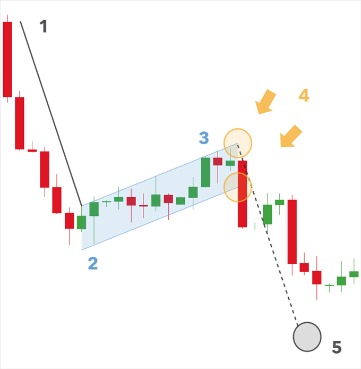Contents:
Again, the lower swing high of the indicator should be confirmed by the lower swing high of the price. Everything has two sides, and indicators are no exception. No matter how great the indicator works, it’ll have something to affect its effectiveness. The MACD indicator was developed by Gerald Appel in the late 1970s.

Global X Adaptive U.S. Risk Management ETF (ONOF): January … – Global X
Global X Adaptive U.S. Risk Management ETF (ONOF): January ….
Posted: Mon, 09 Jan 2023 08:00:00 GMT [source]
A divergence with respect to price may occur on the MACD line and/or the MACD Histogram. In signal processing terms, the MACD series is a filtered measure of the derivative of the input series with respect to time. So, for the standard MACD filter time constants of 12 and 26 days, the MACD derivative estimate is filtered approximately by the equivalent of a low-pass EMA filter of 38 days.
Both moving averages use closing prices of the period that is measured. Therefore, to mitigate risk and confirm the signals further, traders should use the MACD in tandem with additional indicators, such as the RSI indicator. Assuming the standard time ranges, the MACD is calculated by subtracting the value of a 26-period exponential moving average from a 12-period EMA. As its name implies, the MACD is all about the convergence and divergence of the two moving averages.
A momentum indicator calculates the change or speed of the asset’s price movement. Some traders attribute special significance to the MACD line crossing the signal line, or the MACD line crossing the zero axis. Significance is also attributed to disagreements between the MACD line or the difference line and the stock price . Another member of the price oscillator family is the detrended price oscillator , which ignores long term trends while emphasizing short term patterns.
MACD is a popular technical analysis tool that’s usually displayed in a subchart either as a histogram or in line form . The MACD indicator is special because it brings together momentum and trend in one indicator. This unique blend of trend and momentum can be applied to daily, weekly or monthly charts.
What is Moving Average Convergence Divergence (MACD)?
Bullish divergences tend to lead to price reversals, possibly signaling a change in the trend. The signal line is the 9-day EMA of the MACD line itself. In addition to bearish and bullish divergences, the MACD might confirm price movement as well.
- The Relative Strength Index is a momentum indicator that measures the magnitude of recent price changes to analyze overbought or oversold conditions.
- The MACD and RSI are both trend-following momentum indicators often used in tandem to give analysts and traders a better technical understanding of market conditions.
- Convergence is when the price makes a lower high or a lower low, and the indicator makes a higher high or a higher low in the meantime.
- Using the MACD histogram and MACD divergence warnings are two other methods of using the MACD.
- Also, it gives too many false signals on small timeframes, so it is better to use it on price charts with a period of at least one day.
The direction, of course, depends on the direction of the moving average cross. Positive MACD indicates that the 12-day EMA is above the 26-day EMA. Positive values increase as the shorter EMA diverges further from the longer EMA. Negative MACD values indicate that the 12-day EMA is below the 26-day EMA.
how to read the macd Zero Line Crossovers occur when the MACD Line crosses above the Zero Line and go from negative to positive. The MACD indicator is typically good for identifying three types of basic signals; Signal Line Crossovers, Zero Line Crossovers, and Divergence. Aspray’s contribution served as a way to anticipate possible MACD crossovers which are a fundamental part of the indicator. Access to real-time market data is conditioned on acceptance of the exchange agreements.
MACD (Moving Average Convergence/Divergence)
As a moving average of the indicator, it trails the MACD and makes it easier to spot MACD turns. A bullish crossover occurs when the MACD turns up and crosses above the signal line. A bearish crossover occurs when the MACD turns down and crosses below the signal line.
The MACD and average series are customarily displayed as continuous lines in a plot whose horizontal axis is time, whereas the divergence is shown as a bar chart . In addition, pay attention to divergence/convergence between the indicator and the price. Bullish convergence is formed, when the price sets lower lows, while the minimums of the MACD histogram get higher . Bearish divergence is formed, when the price renews highs, while the MACD maximums become lower . The MACD has no bounds, but it has a zero mean, around which it tends to oscillate as the moving averages converge, intersect and diverge.
USD/JPY Price Analysis: Recovery needs validation from 136.50 hurdle – FXStreet
USD/JPY Price Analysis: Recovery needs validation from 136.50 hurdle.
Posted: Tue, 07 Mar 2023 01:36:06 GMT [source]
The Moving Average Convergence Divergence, also called the MACD, is a trend-following momentum indicator used widely by traders. Although the MACD is a lagging indicator, it can be very useful in identifying possible trend changes. Close the position as soon as MACD crosses the signal line in the direction opposite to the entry point. However, don’t close the trade immediately as soon as you notice the MACD crossover. Wait for a candlestick to close to be sure the crossover happened. Sometimes, the MACD gives a sign of reversal because of a weak trend.
Who invented the MACD?
Thanks to all authors for creating a page that has been read 48,223 times. Click on this function and drag it down to the bottom of your data to fill in the rest of the 12 day EMAs. Your data should be formatted with the date in column A and closing price data in column B. The weapon of choice is knowledge and an excellent way to improve your knowledge is with the Trading Challenge.
When it crosses above the centerline, the positive MACD value indicates that the 12-day EMA is greater than the 26-day. In contrast, a negative MACD is shown when the MACD line crosses below the centerline, meaning that the 26-day average is higher than the 12-day. In other terms, a positive MACD line suggests a stronger upside momentum, while a negative one may indicate a stronger drive to the downside. How this system works is that it aims to buy when the MACD confirms the price is moving from a down-trending environment to an up-trending environment.
This is because the MACD tends to oscillate between positions of being overbought when it will form a peak to positions of oversold when it forms a low. Past performance of a security or strategy does not guarantee future results or success. The fast line crossed below the signal line and went below the zero line. Let’s look at figure 2 for an example of how to use the MACD crossover and divergence.
Calculating the Moving Average Convergence Divergence
Traders use the MACD indicator to identify turning points, facilitate entries on pullbacks and capture the larger part of a move until the trend starts to reverse course. Trade only in the direction of the long-term trend if there is one. To avoid these problems, do not enter a trend when the MACD is over-extended in the direction of the trend. The extra wait will often let you enter at a better price.
Notice that MACD is required to be negative to ensure this upturn occurs after a pullback. Divergences form when the MACD diverges from the price action of the underlying security. A bullish divergence forms when a security records a lower low and the MACD forms a higher low.
How does the MACD provide traders with buy/sell signals?
A potential buy signal is generated when the MACD crosses above the MACD Signal Line . This is seen on the Nasdaq 100 exchange traded fund chart below with the two purple lines. We explore what the MACD indicator looks like on an example chart and how you can read it to gain trading insights.

First, notice that we are using https://g-markets.net/ to identify the divergence. The MACD’s moving averages are based on closing prices and we should consider closing prices in the security as well. Second, notice that there were clear reaction lows as both Google and its MACD line bounced in October and late November. Third, notice that the MACD formed a higher low as Google formed a lower low in November. The MACD turned up with a bullish divergence and a signal line crossover in early December. Google confirmed a reversal with a resistance breakout.
… even though I’m about to explain Moving Average Convergence Divergence — I don’t use most of the advanced technical indicators when I trade. In EUR/USD’s 1-hour chart above, the fast line crossed above the slow line while the histogram disappeared. This suggested that the brief downtrend could potentially reverse. This means that we are taking the average of the last 9 periods of the “faster” MACD Line and plotting it as our “slower” moving average.

Crossovers occur when the MACD line crosses above or below the signal line. When the MACD line crosses from below to above the signal line, it’s called a bullish crossover. When the MACD line crosses from above to below the signal line, it’s called a bearish crossover. Because there are two moving averages with different “speeds”, the faster one will obviously be quicker to react to price movement than the slower one.
The reason the MACD is considered a momentum oscillator is because it oscillates around the zero line. The main MACD line is the difference between the 26-period and 12-period EMA. If you look at the chart below you’ll see that in general, the MACD line follows the trend of the stock price. Since the stock’s price is a little choppy, the MACD line is choppy.